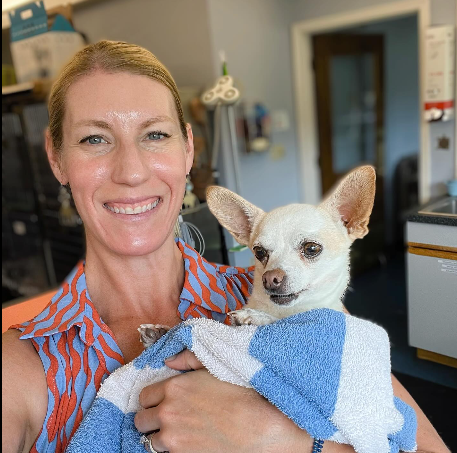Hydrogen peroxide (H2O2) is a common household product that many pet owners keep on hand for various uses. It can be an effective cleaning and disinfecting agent when diluted properly. However, many people wonder if hydrogen peroxide is safe to use on dogs. The answer is not so straightforward. While hydrogen peroxide can be beneficial for some purposes, it can also cause harm if used incorrectly. Here’s a breakdown of how hydrogen peroxide works, including its risks and appropriate uses for dogs.
How Hydrogen Peroxide Works
Hydrogen peroxide is an oxidant, which means it causes oxidation or the loss of electrons from a substance. This is what allows it to break down stain, odors, and microorganisms. Hydrogen peroxide works by releasing oxygen. When it comes into contact with organic matter like skin, blood, and mucus, the hydrogen peroxide breaks down and decomposes into oxygen and water. The rapid release of oxygen creates foaming and bubbling. While this reaction is effective for cleaning wounds and inanimate objects, it can damage living tissues.
Dangers of Ingestion
One of the biggest dangers with hydrogen peroxide is a dog ingesting it, which can happen when it’s left within reach. Ingestion will cause immediate vomiting, foaming at the mouth, and gagging. At higher concentrations or large doses, hydrogen peroxide is caustic and can cause burns or severe inflammation of the mouth, throat, esophagus, and stomach. This can lead to more serious consequences like ulcerations, perforations, sepsis, respiratory arrest, or death in extreme cases. The severity depends on the strength and amount consumed.
Even small amounts of standard 3% hydrogen peroxide sold at most stores can make dogs quite ill. Just a few tablespoons could impact a small dog. It should also NEVER be used to induce vomiting after another toxin or substance is ingested. The vomiting is caustic itself, so inducing more vomiting will compound issues.
Risks with Topical Use
When applied to skin, hydrogen peroxide can also cause irritation, burns, or whitening and discoloration of hair. Using it full-strength or allowing it to sit too long in one area when cleaning wounds can damage healthy tissue and delay healing.
Hydrogen peroxide should always be diluted since volumes above 3% can damage skin just like stronger concentrations are corrosive when ingested. Most experts warn that hydrogen peroxide solutions be diluted to no more than 1-3% for cleaning small wounds, dermatitis, or superficial injuries. Never use it on deep wounds. Splashing it excessively in areas like the eyes can also cause burns or irritation. Burns could also occur mixing it with other cleaning agents like vinegar or baking soda.
Appropriate Uses for Dogs
Hydrogen peroxide does have some safe uses when diluted and used properly on dogs. Here are some appropriate applications:
Ear Cleaning: To remove debris and moisture from dog ears due to infections, hydrogen peroxide can be effective. A veterinarian may prescribe a special cleaner with prescribed ingredients and ratios. Over-the-counter mixtures typically contain hydrogen peroxide diluted with water and acetic acid for pH balancing. These eardrops should be diluted and acidified correctly to avoid burns. Follow directions carefully and avoid getting the solution into the inner ear.
Minor Wound/Skin Cleaning: For a mild skin abrasion, hydrogen peroxide can help remove debris and kill bacteria when diluted. Always start with a more diluted mixture first like 1-2% rather than 3%. Flush the area thoroughly with running water as well.
Disinfecting: As a household disinfectant, hydrogen peroxide makes a good alternative to chlorine bleach solutions which can be unsafe for dogs. A 1:32 dilution of 3% hydrogen peroxide in water is effective against various bacteria, viruses, yeasts, fungi and spores with a contact time of at least 5 minutes. This makes it useful for disinfecting surfaces, floors, pet items, toys, leashes, bowls, and litter boxes.
Stain Removal: As a stain remover, hydrogen peroxide can be an effective pre-treatment for bodily fluids and mud. Use a 3% solution initially then flush and rinse thoroughly with water if applied directly on fabric while your dog is wearing it. Test an inconspicuous area first and don’t allow it to sit too long to avoid bleaching some fabric dyes. For carpet stains, it can lift stains enough to then work in an enzymatic pet cleaner. Rinse thoroughly afterward with water.
Vomit/Fecal Stain Cleaning: Hydrogen peroxide helps remove organic stains and deodorize areas where a dog has had an accident or vomit by breaking down the proteins. Use a spray bottle to cover the entire stain. Let it sit for a minute or two before blotting and rubbing with a clean cloth or paper towel. Rinse thoroughly with water afterward and allow the area to dry completely before having your dog near the area again. Then apply an enzyme cleaner formulated to remove pet stains.
Eliminating Skunk Odor: One of the most popular remedies for removing the putrid spray of skunks is a hydrogen peroxide solution. Combine 1 quart of 3% hydrogen peroxide, 1/4 cup of baking soda, and 1-2 teaspoons of liquid dish detergent in a bucket. Sponge the mixture directly onto your dog’s coat while avoiding the eyes, nose, and mouth. Let sit 5-10 minutes before a thorough rinsing. Repeat if necessary. This oxidizes the skunk thiols to sulfonic acid which eliminates odor rather than just masking it. The dish soap allows it to penetrate better. Still, avoid over-application in any one area of skin.
Summary
It’s clear hydrogen peroxide requires cautious handling and dilution for dog use. However, it can provide an economic, effective cleaning solution over more mainstream products when specific precautions are followed as listed below:
– Never induce vomiting after ingestion. Seek emergency veterinary care immediately.
– Heavily dilute any application on the skin or coat. Start with 1-2% solutions first.
– Always spot test fabrics for colorfastness when attempting stain removal.
– Completely flush skin applications with running water and avoid contact with eyes or mouth.
– Read and follow directions carefully for cleaners containing hydrogen peroxide.
– Never use higher concentrations than recommended. More is NOT better!
So while hydrogen peroxide requires a delicate handling, it still stands as a helpful staple for pet stain removal, disinfecting, and minor first aid when correctly diluted and rinsed. Just be very conscious of safety procedures and monitor your dog closely during and after any hydrogen peroxide use. Seek veterinary advice if you have any concerns about application or accidental ingestion. With cautious usage, hydrogen peroxide can be integrated beneficially into pet care.

Dr. Allison Kramer is a seasoned veterinarian with a Master’s degree in Animal Behavior and over 10 years of experience specializing in canine health and behavior. Her expertise in positive reinforcement training and holistic care enhances the well-being of dogs and fosters strong pet-owner relationships. For expert advice and valuable insights, follow Dr. Kramer on Instagram @dr.allisonkramer.





